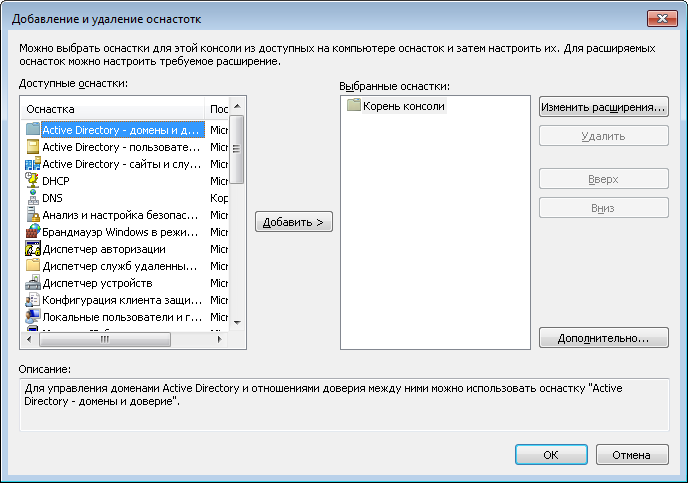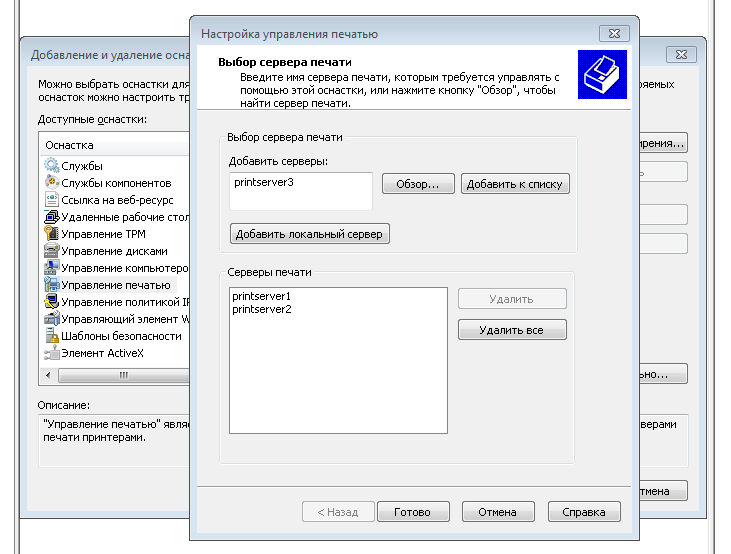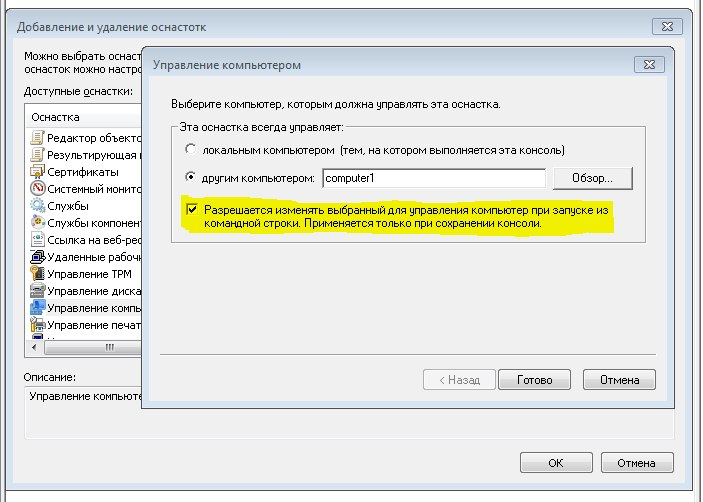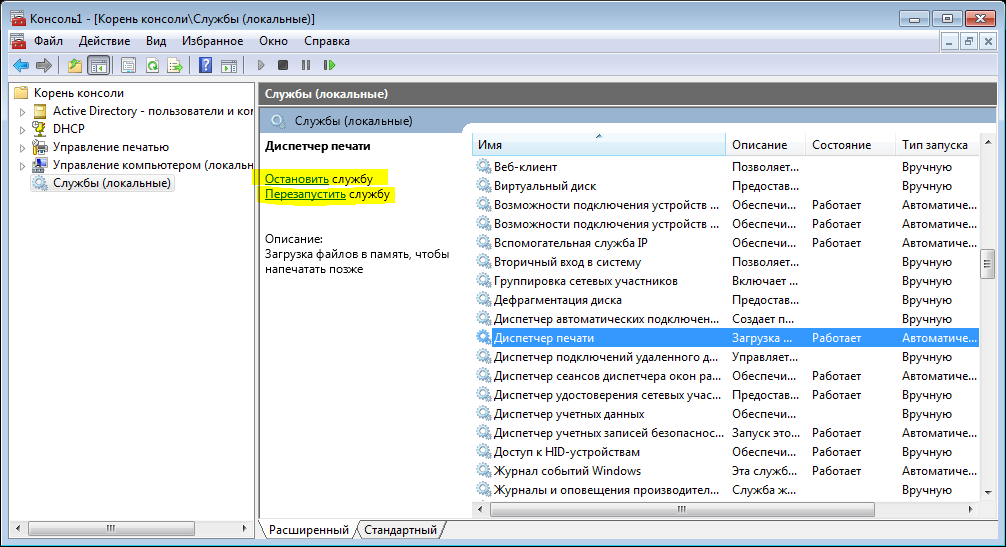Creating the MMC Management Console
- Tutorial
Have you seen the cockpit? Everything is at hand, no unnecessary gestures. In order to take off, the pilot does not go to the other end of the aircraft to turn on the engine.

So it is with MMC consoles. You create a “control panel” for yourself and in certain situations click on the necessary “buttons”.
The publication is intended for system administrators who want to get acquainted with the method of creating Windows management consoles by using mmc.exe.
Microsoft answers :
I like to characterize the MMC console as a control panel. By adding all the necessary tools to it, you can save a lot of time. Everything you need is always in front of you, in one place.
Pros of use:
+ You are not constantly looking for shortcuts to the used snap-ins, programs, scripts;
+ To start the working day, you need to run only one file;
+ Ability to create your own consoles for different tasks, projects or for each serviced office.
The modular system allows you to combine various snap-ins in one place, it can be a server’s resource monitor and the most common web page browser. We will review the latest MMC version 3.0 shipped with Windows Server 2003 SP2, Windows Server 2003 R2, Windows Vista, Windows 7, and Windows Server 2008. The history of management consoles began with MMC 1.0 and Windows 95.
The management console is located on the path C: \ Windows \ System32 \ mmc.exe .

By launching the console in this way, we will open it in the Author mode, i.e. we can make changes to the structure. MMC consoles have two launch modes:
You can change the launch mode in the console itself or, for example, for author mode, start with the / a parameter . We will consider this moment at the end when we will already create our first console.
An empty console looks like this:

To run 32-bit MMC consoles on 64-bit systems, the console must be started with the / 32 option.
If you run the 64-bit console on a 32-bit system, it will be completed.
We decided that the console should simplify the system administration process. For clarity, I propose to highlight a set of snap-ins and functionality that a typical system administrator in any of the companies has in one form or another:
Having chosen all the most basic, we will proceed to create our own management console.
The process of adding snap-ins to the console is intuitive: File - Add or remove snap-

ins ... To add some snap-ins, you will not need to make any additional settings right away:

When adding others, you will be asked to configure them immediately:

When adding a number of snap-ins, a choice is offered computer to control. For example, when you add the Computer Management and Services snap-ins . Since we plan to use the console to control other computers, you should pay attention to the checkbox and put it down:
If you are making the snap-in universal for connecting to any computer, then the best option at this point is the local computer . If there is a “different computer”, then every time we start the console we created, there will be requests to the remote computer ... And if it is turned off? You will have to wait until the snap will understand this and give an error.

After clicking on OK, we get a console with the snap-ins added by us:

But we are not happy with how it looks, we want to hide some elements. The Actions field takes up too much space, we want to get rid of it and, for example, get rid of the status bar . Customize the appearance of the console can be made in the menu View - Customize ... .

Here we can remove and enable the display of the elements we need. We put down the checkboxes and see the result:

On the taskbar of some snap-ins, we can see a set of some standard actions and properties. Other snap-ins may not have a standard taskbar at all.
The Service snap-in , for example, contains buttons that let you Stop and Restart a service. We can change the appearance of the taskbar and add to it the actions that we need.

To do this, first click on the snap-in in the root of the console (in this case, click on Services (local) ) and fail in the Actions menu - New view of the taskbar ...

The taskbar view wizard opens. Click on.

Choose a style for our new taskbar. We draw attention to the fact that the wizard gives us tips on what style is suitable for what and shows in the preview window how it will look:

In the next step, we select to which console elements we add the taskbar view that we created. If you select the To all elements of the type of the selected element item , then if we had another snap-in of the Service in the console, this view would also apply to it. If we select To the selected tree element , then the view applies only to the selected snap-in in the root of the console.

Now we just have to give the name of the taskbar and, if we want, add a description.

At the final step, we are prompted after clicking on the Finish button to add a new task to the just created taskbar.

Since we did not remove the checkbox at the last step, we are presented with the Task Creation Wizard .

Choose the type of command for the task to be created. We are given three types to choose from:
We will select the menu item Command .

With the command source, select Element in the results pane .

We indicate the name and optional description of our team.

Choose your favorite task icon from the available ones or upload your own.

At the final step, click Finish . If we want to add another task, set the corresponding checkbox.

After the wizard finishes, choosing a service on the taskbar that we created, we will see the Restart task added by us, when you click on it, the service will restart, you can


add such task panels with tasks any snap.
The next step, we will add to the root of our console a point from which we will run our working scripts and scripts: File - Add or remove snap-in ...
Add snap-in Folder :

In the root of the console, rename it and create a new taskbar: Action - New view of the taskbar ...

The panel style, for convenience, is selected without a list and applied to the selected list item.

We finish the creation by choosing a name and adding a description.
We start the task creation wizard and this time select the item Operating system command :

To run, for example, a PowerShell script, in the Command field, write powershell , and in the Parameters field- the path to the script. In our case, we indicate the path to the script C: \ Console \ script \ new-user.ps1 .
If we save our console to the C: \ Console folder , then we can specify the path script \ new-user.ps1 to the script .

Add a name and description, select the task icon and complete the creation.

When you select the Scripts folder in the root of the console, we see the link to the script that was just created.

Thus, we can add all the utilities and scripts
that we need to add. In order to add another task, after exiting the wizard, we select the necessary snap-in in the root of the console: Action - Edit the taskbar view ... General
tab for setting the style of displaying the taskbar.

Tasks tab to add new tasks, delete and modify an existing one.

To add a new task, click the Create ... button, the Create Task Wizard opens and we can add a new task, similar to the previous one. For example, we will add a link to the execution of the .reg file. To do this, when creating a command in the field, write the path C: \ Console \ Settings.reg .
To run, for example, an .exe file with parameters, we will need to register the path to the file in the Command field and launch parameters in the Parameters field .

Next, let's start adding links to network resources. These can be folders located locally on a computer or on the network, or links to web pages.
File - Add or Remove Snap-in ...
Since we want all resources have been ordered, adding a new snap-in folder and that in it could put other snap-ins, click on the button Advanced and set the checkbox Allow changing the parent snap .

In the Parent snap -in list, select Folder and add another snap-in - Link to a web resource :

If the location is on the network, enter the path. For example, on server1soft shared folder

Enter a name and click Finish


In the root of the console, rename our folder, for example, to Network resources. We open it and see the link we created to the network folder soft . By clicking on the soft folder , we will see its contents.
As mentioned earlier, in this way you can add links to local and network folders, as well as to web resources.

Finally, we will add the Remote Desktops snap-in to our console .

After adding a snap, right-click on it and select the Add new connection ... item .

Enter the computer name or ip-address and name for the connection.

When choosing our terminal, we will connect to it from the console window.

At the beginning, we talked about the fact that some snap-ins work either with the current local computer or with another, remote one.
Take, for example, the Computer Management snap -in . Make a right click on the snap - Connect to another computer ... .

Enter the name of another computer, click OK .

If the computer exists, we get the console controlling another computer.

If not, then we see an error.

Now we need to save our new console. File - Save as ... .
When you exit the console, we will receive offers to save the changes.

When you re-open the console, we will again enter it in the Author mode, allowing you to make changes in the structure. But we, for example, do not want the end user to be able to make any changes. To do this, change the default startup mode.
Choose File - Options ...

Choose, for example, User - full access . Click Apply and OK .
This mode will allow you to work with existing snap-

ins and will not allow you to add or remove new ones. We exit the snap-in with saving.
If at the exit, for example, we had the Computer Management snap-in expanded, when you save and after re-opening the console, we will also see the expanded Computer Management snap-in.

This is where we finished creating our management console. It is fully ready for use by the system administrator.
Create consoles, experiment, simplify the work!

So it is with MMC consoles. You create a “control panel” for yourself and in certain situations click on the necessary “buttons”.
The publication is intended for system administrators who want to get acquainted with the method of creating Windows management consoles by using mmc.exe.
What is an MMC console?
Microsoft answers :
Microsoft Management Console (MMC) —A location for storing and displaying administration tools created by Microsoft and other software vendors. These tools are called snap-ins and are used to manage Windows hardware, software, and network components. Some tools located in the Administration folder, such as Computer Management, are MMC snap-ins.
Introduction
I like to characterize the MMC console as a control panel. By adding all the necessary tools to it, you can save a lot of time. Everything you need is always in front of you, in one place.
Pros of use:
+ You are not constantly looking for shortcuts to the used snap-ins, programs, scripts;
+ To start the working day, you need to run only one file;
+ Ability to create your own consoles for different tasks, projects or for each serviced office.
The modular system allows you to combine various snap-ins in one place, it can be a server’s resource monitor and the most common web page browser. We will review the latest MMC version 3.0 shipped with Windows Server 2003 SP2, Windows Server 2003 R2, Windows Vista, Windows 7, and Windows Server 2008. The history of management consoles began with MMC 1.0 and Windows 95.
The management console is located on the path C: \ Windows \ System32 \ mmc.exe .

By launching the console in this way, we will open it in the Author mode, i.e. we can make changes to the structure. MMC consoles have two launch modes:
- Copyright - in which we will have complete freedom of action and we will be able to remove and add snap-ins;
- User - prohibiting changes in the structure and suitable for the end user.
You can change the launch mode in the console itself or, for example, for author mode, start with the / a parameter . We will consider this moment at the end when we will already create our first console.
An empty console looks like this:

The moment about the capacity of consoles (MMC32 and MMS64)
To run 32-bit MMC consoles on 64-bit systems, the console must be started with the / 32 option.
If you run the 64-bit console on a 32-bit system, it will be completed.
"My first console"
We decided that the console should simplify the system administration process. For clarity, I propose to highlight a set of snap-ins and functionality that a typical system administrator in any of the companies has in one form or another:
- Active Directory snap-in
- DHCP snap-in
- Manage print servers
- Computer management;
- Service management;
- A set of scripts and utilities;
- A set of network resources;
- A set of remote desktops;
Having chosen all the most basic, we will proceed to create our own management console.
The process of adding snap-ins to the console is intuitive: File - Add or remove snap-

ins ... To add some snap-ins, you will not need to make any additional settings right away:

When adding others, you will be asked to configure them immediately:
When adding a number of snap-ins, a choice is offered computer to control. For example, when you add the Computer Management and Services snap-ins . Since we plan to use the console to control other computers, you should pay attention to the checkbox and put it down:
Allow changing the computer selected for control at startup from the command line. It is used when saving the console.
If you are making the snap-in universal for connecting to any computer, then the best option at this point is the local computer . If there is a “different computer”, then every time we start the console we created, there will be requests to the remote computer ... And if it is turned off? You will have to wait until the snap will understand this and give an error.
After clicking on OK, we get a console with the snap-ins added by us:

But we are not happy with how it looks, we want to hide some elements. The Actions field takes up too much space, we want to get rid of it and, for example, get rid of the status bar . Customize the appearance of the console can be made in the menu View - Customize ... .

Here we can remove and enable the display of the elements we need. We put down the checkboxes and see the result:

On the taskbar of some snap-ins, we can see a set of some standard actions and properties. Other snap-ins may not have a standard taskbar at all.
The Service snap-in , for example, contains buttons that let you Stop and Restart a service. We can change the appearance of the taskbar and add to it the actions that we need.
To do this, first click on the snap-in in the root of the console (in this case, click on Services (local) ) and fail in the Actions menu - New view of the taskbar ...

The taskbar view wizard opens. Click on.

Choose a style for our new taskbar. We draw attention to the fact that the wizard gives us tips on what style is suitable for what and shows in the preview window how it will look:

In the next step, we select to which console elements we add the taskbar view that we created. If you select the To all elements of the type of the selected element item , then if we had another snap-in of the Service in the console, this view would also apply to it. If we select To the selected tree element , then the view applies only to the selected snap-in in the root of the console.

Now we just have to give the name of the taskbar and, if we want, add a description.

At the final step, we are prompted after clicking on the Finish button to add a new task to the just created taskbar.

Since we did not remove the checkbox at the last step, we are presented with the Task Creation Wizard .

Choose the type of command for the task to be created. We are given three types to choose from:
- Menu command - launches the standard snap menu command.
- Operating system command - allows us to run a program, script or script.
- Navigation Command - Displays the taskbar for an item from the MMC favorites list
We will select the menu item Command .

With the command source, select Element in the results pane .

We indicate the name and optional description of our team.

Choose your favorite task icon from the available ones or upload your own.

At the final step, click Finish . If we want to add another task, set the corresponding checkbox.

After the wizard finishes, choosing a service on the taskbar that we created, we will see the Restart task added by us, when you click on it, the service will restart, you can


add such task panels with tasks any snap.
The next step, we will add to the root of our console a point from which we will run our working scripts and scripts: File - Add or remove snap-in ...
Add snap-in Folder :

In the root of the console, rename it and create a new taskbar: Action - New view of the taskbar ...

The panel style, for convenience, is selected without a list and applied to the selected list item.

We finish the creation by choosing a name and adding a description.
We start the task creation wizard and this time select the item Operating system command :

To run, for example, a PowerShell script, in the Command field, write powershell , and in the Parameters field- the path to the script. In our case, we indicate the path to the script C: \ Console \ script \ new-user.ps1 .
If we save our console to the C: \ Console folder , then we can specify the path script \ new-user.ps1 to the script .

Add a name and description, select the task icon and complete the creation.

When you select the Scripts folder in the root of the console, we see the link to the script that was just created.

Thus, we can add all the utilities and scripts
that we need to add. In order to add another task, after exiting the wizard, we select the necessary snap-in in the root of the console: Action - Edit the taskbar view ... General
tab for setting the style of displaying the taskbar.

Tasks tab to add new tasks, delete and modify an existing one.

To add a new task, click the Create ... button, the Create Task Wizard opens and we can add a new task, similar to the previous one. For example, we will add a link to the execution of the .reg file. To do this, when creating a command in the field, write the path C: \ Console \ Settings.reg .
To run, for example, an .exe file with parameters, we will need to register the path to the file in the Command field and launch parameters in the Parameters field .

Next, let's start adding links to network resources. These can be folders located locally on a computer or on the network, or links to web pages.
File - Add or Remove Snap-in ...
Since we want all resources have been ordered, adding a new snap-in folder and that in it could put other snap-ins, click on the button Advanced and set the checkbox Allow changing the parent snap .

In the Parent snap -in list, select Folder and add another snap-in - Link to a web resource :

If the location is on the network, enter the path. For example, on server1soft shared folder

Enter a name and click Finish


In the root of the console, rename our folder, for example, to Network resources. We open it and see the link we created to the network folder soft . By clicking on the soft folder , we will see its contents.
As mentioned earlier, in this way you can add links to local and network folders, as well as to web resources.

Finally, we will add the Remote Desktops snap-in to our console .

After adding a snap, right-click on it and select the Add new connection ... item .

Enter the computer name or ip-address and name for the connection.

When choosing our terminal, we will connect to it from the console window.

At the beginning, we talked about the fact that some snap-ins work either with the current local computer or with another, remote one.
Take, for example, the Computer Management snap -in . Make a right click on the snap - Connect to another computer ... .

Enter the name of another computer, click OK .

If the computer exists, we get the console controlling another computer.

If not, then we see an error.

Now we need to save our new console. File - Save as ... .
When you exit the console, we will receive offers to save the changes.

When you re-open the console, we will again enter it in the Author mode, allowing you to make changes in the structure. But we, for example, do not want the end user to be able to make any changes. To do this, change the default startup mode.
Choose File - Options ...

Choose, for example, User - full access . Click Apply and OK .
This mode will allow you to work with existing snap-

ins and will not allow you to add or remove new ones. We exit the snap-in with saving.
If at the exit, for example, we had the Computer Management snap-in expanded, when you save and after re-opening the console, we will also see the expanded Computer Management snap-in.

This is where we finished creating our management console. It is fully ready for use by the system administrator.
Create consoles, experiment, simplify the work!
Additional Information
Only registered users can participate in the survey. Please come in.
Do you use MMC management consoles in your work?
- 29.1% Yes, I use 133
- 37.5% Seen, I know, but I do not use 171
- 30.9% No, never used 141
- 9.6% I do not work with Windows 44 systems
